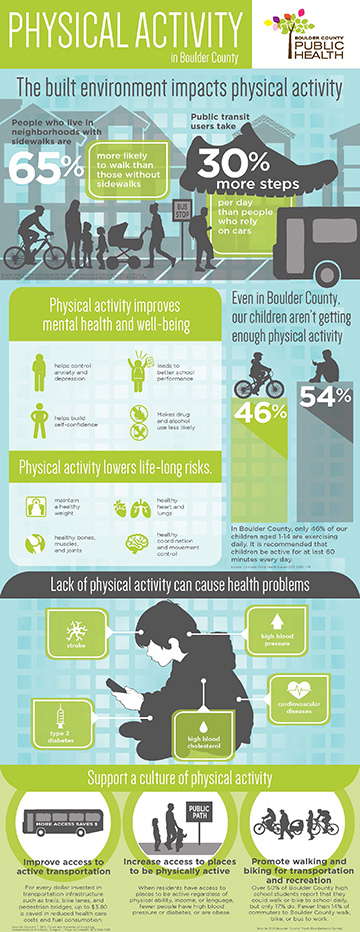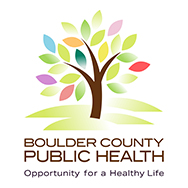Health Benefits of Physical Activity
Staying physically active is good for individuals and entire communities. People who have easy access to safe exercise spaces are much more likely to take advantage of them.
Physical Activity in Boulder County
In Boulder County, 89% of adults are active. However, many children in the county are not getting the activity they need to reap the health and social-emotional benefits. In Boulder County, just over half (52%) of children aged 5-14 years old exercise daily.
Among high school-aged youth, 73.8% report engaging in 60 minutes of vigorous physical activity at least 3 of the previous 7 days; however, the recommendation for high school students is 60 minutes of physical activity every day.
In Boulder County
- Three out of ten adults in Boulder County are overweight or obese.
- Of high school students in Boulder County, 16% are overweight or obese.
- 12% of our preschoolers in low-income families are considered obese.
Benefits of Physical Activity
Research demonstrates that active children become active adults. Physical activity helps children
- Maintain a healthy weight
- Develop healthy bones, muscles, and joints
- Establish a healthy heart and lungs
- Help maintain a healthy weight
- Contribute to healthy coordination and movement control (neuro-muscular awareness)
Social/Emotional Benefits
Being physically active also has health benefits beyond physical health, including:
- Improved mental health
- Opportunities for self-expression and social interaction
- Increased self-confidence
- Better academic performance
- Decrease in risky behaviors like using alcohol, tobacco, and other drugs
Cultural Factors
A person’s income, experience, culture, and environment impact their opportunity to live a healthy life. Eating well and staying active has become more complex as society, culture, and our environment change.
Compared to 50 years ago, Americans today:
- Sit more
- Walk less
- Eat fewer fruits and vegetables
- Consume more sugar
Physical Activity Guidelines
The National Physical Activity Guidelines for the U.S. recommend that children aged 6-18 need at least 60 minutes of moderate or vigorous physical activity daily.
Guidelines for early childhood centers call for:
- Two to three occasions of unstructured outdoor play
- Two or more structured activities
- Continuous opportunities to engage in age-appropriate gross motor and movement skills
Toddlers need a minimum of 60 – 90 minutes of moderate to vigorous play per day, and preschoolers should have 90-120 minutes of moderate to vigorous play per eight hours in a care setting.
Physical Activity Disparities
Latino/Hispanic middle and high school students are less likely than their non-Latino/Hispanic Caucasian classmates to exercise vigorously three or more times a week; are more likely to watch three or more hours of television and play three or more hours of video games per day.
Built Environment
Our Built Environment Influences Our Health Behaviors
The term “built environment” refers to the man-made elements that surround us. For example:
- Sidewalks
- Crosswalks
- School zones
- Parks
- Water supply
- Infrastructure
- Bike paths
How our physical environment is designed and built impacts the health of the people who live there. In neighborhoods where bicycling and walking are more common, fewer people are obese or have high blood pressure or diabetes.
Safe Walking Spaces Encourage Physical Activity
In areas where people had safe places to walk within 10 minutes of home, 43% of residents met recommended physical activity levels, while just 27% of residents without safe places to walk met recommended activity levels. Residents are 65% more likely to walk in neighborhoods with sidewalks than those without.
The health benefits of active transportation can outweigh any risks associated with these activities by as much as 77 to 1. As much as $11.80 in benefits can be gained from every $1 invested in bicycling and walking.
Built Environment Disparities
Many disparities exist in who has access to a built environment that supports healthy behaviors. For example, in the U.S., 81% of Hispanic neighborhoods and 70% of African-American neighborhoods lack recreational facilities.
In Boulder County
Boulder County is committed to helping our community build healthy places for people to live and play.




